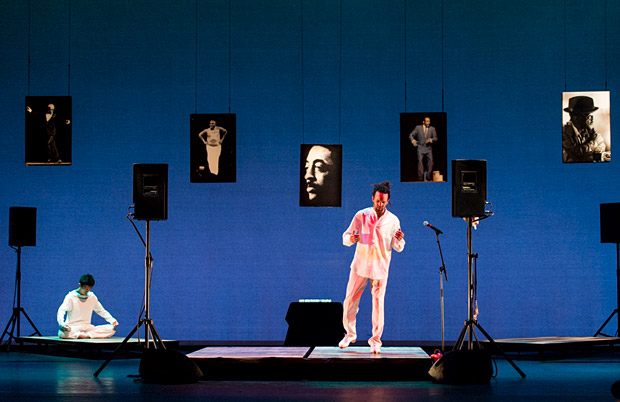
© Foteini Christofilopoulou. (Click image for larger version)
Savion Glover
SoLe Sanctuary
London, Sadler’s Wells
4 April 2014
Gallery of photographs by Foteini Christofilopoulou
www.saviongloverproductions.com
www.sadlerswells.com
Savion Glover’s latest show is the ultimate exposition of world-beating virtuosity, performed as an act of spiritual devotion that venerates past leaders of the Hoofer faith. But, it also taps dangerously close to zealous self-indulgence in a theatrical experience that drifts from initial marvel towards eventual tedium. The performance is effectively one unbroken conversation, mostly expressed through long monologues, delivered exclusively through the language of percussion. And these performers have their mouths firmly in their feet.
The religious allusion is labelled upfront in the title. Notwithstanding the unclear reason for the major case ‘L’ in this metaphor, it is plain that the dance cathedral of Sadler’s Wells has indeed become a Sanctuary, in which the moving spirit is the sole (or, to be strictly accurate, four of them). The prevailing aspect of monastic piety is accentuated by the only man to remain on stage permanently during this 100-minute performance being deep in meditation throughout, imperceptibly changing his opening cross-legged pose to similar inactive positions of deep contemplation. In striking contrast to the two hoofers this uncredited extra barely uses his feet at all.
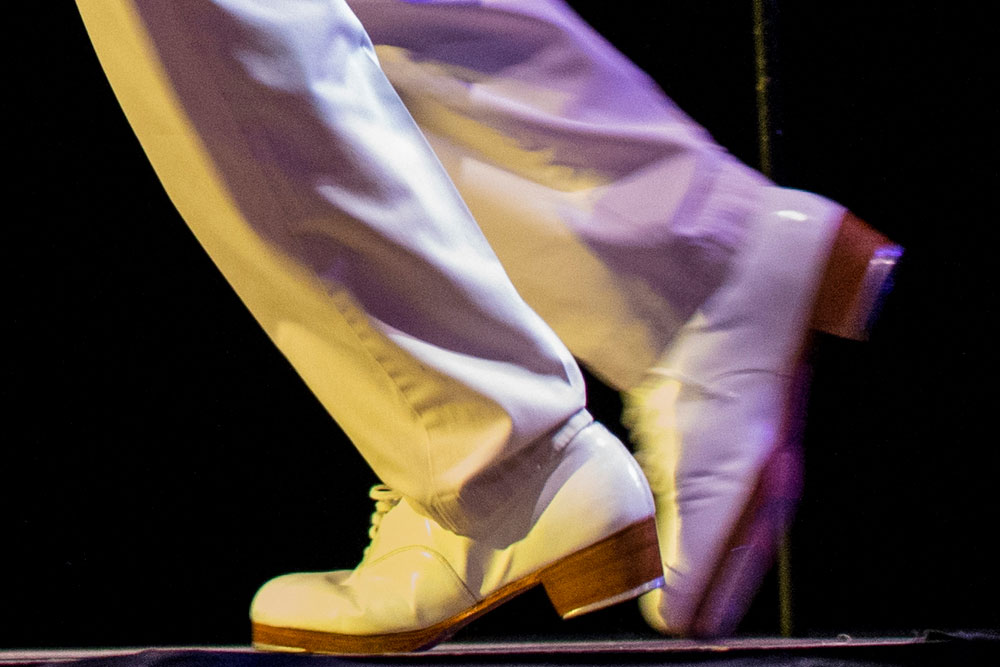
© Foteini Christofilopoulou. (Click image for larger version)
That the stage has become a place of worship is emphasised by seven large portraits of tap-dancing legends unevenly suspended above the performers. At several points during the performance, each is illuminated in turn. Amongst this Magnificent Seven, Gregory Hines – often described by Glover as his mentor – and Sammy Davis Jr were instantly recognisable. The others, I believe, were Jimmy Slyde (the “King of Slides”), Lon Chaney and Bunny Briggs (premier exponents of the paddle and roll), Buster Brown and Charles ‘Honi’ Coles. All except Briggs (now 92) have passed on. Hines was just 57 when he died in 2003 having expanded his career well beyond the art of classical tap (he can still be seen on TV virtually every day as Will’s suave lawyer boss in the evergreen US sitcom Will and Grace). The announcement of his death in the New York Times came via Savion Glover’s mother (and manager), Yvette.
A heavily amplified, surprisingly small, raised platform acts in place of a pulpit on which Glover and his associate, Marshall Davis Jr, beat out their devotions in thousands upon thousands of subtle movements of their feet. Their status as the inheritors of the legacy of tap is referenced in the programme’s sub-title, which describes them as The Last HooFeRZ Standing (and I am again in the dark as to the significance of the random major case lettering). The show’s choreography is attributed to Spirits Known (clearly a reference to the men in the seven portraits), although a sequence known as Improvography is specifically credited to Hines and Slyde.
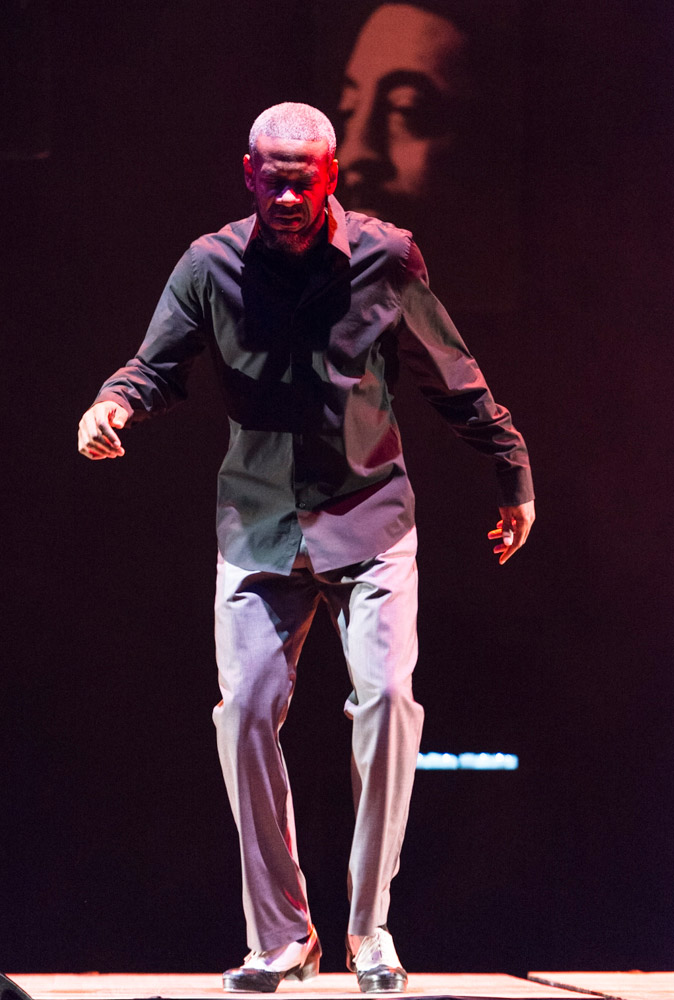
© Foteini Christofilopoulou. (Click image for larger version)
Glover is dressed in white – including tap shoes – and some of the brief accompanying voiceover lists the former gurus of tap, as a Christian priest might read out the names of saints during a mass. He begins slowly, gradually building up a long, unbroken solo and it is impossible not to marvel at the brilliance of his technique, while trying to fathom how it is possible to produce so many sounds from one pair of feet and simultaneously maintain the rigour of his rhythmic precision. Sometimes Glover’s upper body feels as if it is about to over-balance, at one point it shivers in response to the ferocity of his tapping and elsewhere it is almost still, perhaps with one wrist dangling towards the source of the beat. There are several junctures when it seems as if Glover may actually be in a trance. In one very brief sequence, he picks up a handily-placed microphone and sings his own accompaniment. For the most part the sound of tap-dancing is the only music although it is a mystery as to how it is possible to broadcast so many drums in just two feet.
Several minutes into the show and today’s Davis Jr (what a great name for a tap dancer) casually wanders on with a towel and a bottle of water. He joins Glover for most of the rest of the show and they dance separately, together and in a mutual exchange (the Improvography?) where they repeat and build upon each other’s step challenges. When Glover is dancing alone one has an overwhelming feeling that he is improvising (and he is quoted as saying that no two shows will be the same) but there is an intensely disciplined structure in the way the two hoofers suddenly explode into perfect harmony in the most complex of routines. When they do it is with a compelling mutual artistry that provides the most absorbing aspect of the whole show.

© Foteini Christofilopoulou. (Click image for larger version)
Religious imagery also pervades the titles of the programme’s 11 sections (such as Entering the Monastery of His Out’ness, The Offering, The High Priest of Gone and Amen) although the breaks between one sequence and the next are not often obvious. There is no clear sense of individual dances building to a crescendo or conclusion: instead, they seem to morph into each other, hence the idea of the unbroken conversation. Each dancer takes a break while the other carries on and their downtime is spent towelling down, walking around or watching their colleague, thus adding an intimate informality to the programme.
It is impossible not to appreciate the sincere reverence with which Glover respects the great hoofers of the past, nor to realise that these two guys are themselves the crème de la crème of this generation. I suspect that there were many subtleties in their performances that matched the particular skills of the Spirits Known but one needs an intensely detailed knowledge of their art to fully admire this four-shoe show. A steady trickle of people left before the end, obviously giving up on the hope that the action was going to diversify into something more mainstream Gene Kelly. SoLe Sanctuary may have a strong sense of soul but it lacks the sense of theatre to go with it.












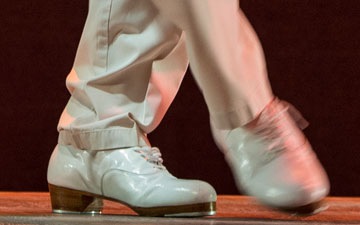
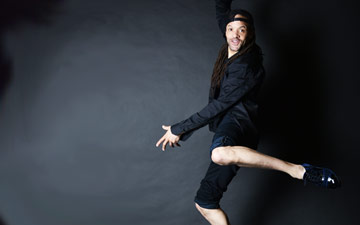
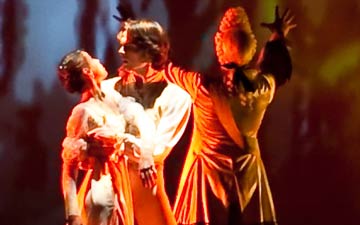
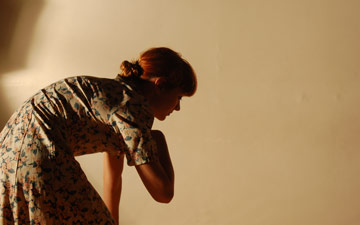

You must be logged in to post a comment.